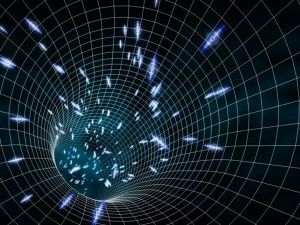Page 8216
Jan 21, 2020
A Clock that Will Last Forever
Posted by Quinn Sena in categories: particle physics, quantum physics
Circa 2012
Imagine a clock that will keep perfect time forever or a device that opens new dimensions into quantum phenomena such as emergence and entanglement.
Imagine a clock that will keep perfect time forever, even after the heat-death of the universe. This is the “wow” factor behind a device known as a “space-time crystal,” a four-dimensional crystal that has periodic structure in time as well as space. However, there are also practical and important scientific reasons for constructing a space-time crystal. With such a 4D crystal, scientists would have a new and more effective means by which to study how complex physical properties and behaviors emerge from the collective interactions of large numbers of individual particles, the so-called many-body problem of physics. A space-time crystal could also be used to study phenomena in the quantum world, such as entanglement, in which an action on one particle impacts another particle even if the two particles are separated by vast distances.
Jan 21, 2020
Record-breaking terahertz laser beam
Posted by Quinn Sena in categories: biotech/medical, security
Terahertz radiation is used for security checks at airports, for medical examinations and also for quality checks in industry. However, radiation in the terahertz range is extremely difficult to generate. Scientists at TU Wien have now succeeded in developing a terahertz radiation source that breaks several records: it is extremely efficient, and its spectrum is very broad—it generates different wavelengths from the entire terahertz range. This opens up the possibility of creating short radiation pulses with extremely high radiation intensity. The new terahertz technology has now been presented in the journal Nature Communications.
The “Terahertz Gap” Between Lasers and Antennas
“Terahertz radiation has very useful properties,” says Claudia Gollner from the Institute of Photonics at TU Wien. “It can easily penetrate many materials, but unlike X-rays, it is harmless because it is not ionizing radiation.”
Jan 21, 2020
A star called Betelgeuse might be ready to explode into a giant supernova
Posted by Quinn Sena in category: cosmology
If we confirm its in its final phase of life, we might learn how to actually predict when these red supergiant stars suddenly explode.
Jan 21, 2020
Experts Were Wrong: Chinese Virus Is Spreading Between Humans
Posted by Quinn Sena in category: biotech/medical
Jan 21, 2020
First U.S. case of potentially deadly Chinese coronavirus confirmed in Washington state
Posted by Quinn Sena in categories: biotech/medical, health
The man, in his 30s, is in stable condition at Providence Regional Medical Center in Everett, Wash. Officials said they are monitoring him there out of an abundance of caution, not because he is seriously ill. The man arrived in the United States last week, before federal health officials began screening travelers from the central Chinese city of Wuhan at Los Angeles, San Francisco and New York’s John F. Kennedy international airports, the first such effort since the 2014 Ebola outbreak.
Jan 21, 2020
Why Google thinks we need to regulate AI
Posted by Michael Lance in category: robotics/AI
Sundar Pichai, CEO of Google, calls for sensible regulation of AI. I agree. “Companies such as ours cannot just build promising new technology and let market forces decide how it will be used. It is equally incumbent on us to make sure that technology is harnessed for good and available to everyone.”
Companies cannot just build new technology and let market forces decide how it will be used.
Jan 21, 2020
Capella Space reveals new satellite design for real-time control of high-resolution Earth imaging
Posted by Genevieve Klien in categories: satellites, sustainability

Satellite and Earth observation startup Capella Space has unveiled a new design for its satellite technology, which improves upon its existing testbed hardware platform to deliver high-resolution imaging capable of providing detail at less than 0.5 meters (1.6 feet). Its new satellite, code-named “Sequoia,” also will be able to provide real-time tasking, meaning Capella’s clients will be able to get imaging from these satellites of a desired area basically on demand.
Capella’s satellites are “synthetic aperture radar” (SAR for short) imaging satellites, which means they’re able to provide 2D images of the Earth’s surface even through cloud cover, or when the area being imaged is on the night side of the planet. SAR imaging resolution is typically much higher than the 0.5-meter range that Capella’s new design will enable — and it’s especially challenging to get that kind of performance from small satellites, which is what Sequoia will be.
Jan 21, 2020
Can Synthetic Biology Inspire The Next Wave Of AI?
Posted by Genevieve Klien in categories: bioengineering, biological, robotics/AI, transportation
Computers can beat humans at sophisticated tasks like the game Go, but can they also drive a car, … [+] speak languages, play soccer, and perform a myriad of other tasks like humans? Here’s what AI can learn from biology.
Jan 21, 2020
How Researchers Used AI to Better Understand Biological Vision
Posted by Genevieve Klien in categories: biological, neuroscience, robotics/AI

A few years back, DeepMind’s Demis Hassabis famously prophesized that AI and neuroscience will positively feed into each other in a “virtuous circle.” If realized, this would fundamentally expand our insight into intelligence, both machine and human.
We’ve already seen some proofs of concept, at least in the brain-to-AI direction. For example, memory replay, a biological mechanism that fortifies our memories during sleep, also boosted AI learning when abstractly appropriated into deep learning models. Reinforcement learning, loosely based on our motivation circuits, is now behind some of AI’s most powerful tools.
Continue reading “How Researchers Used AI to Better Understand Biological Vision” »
















